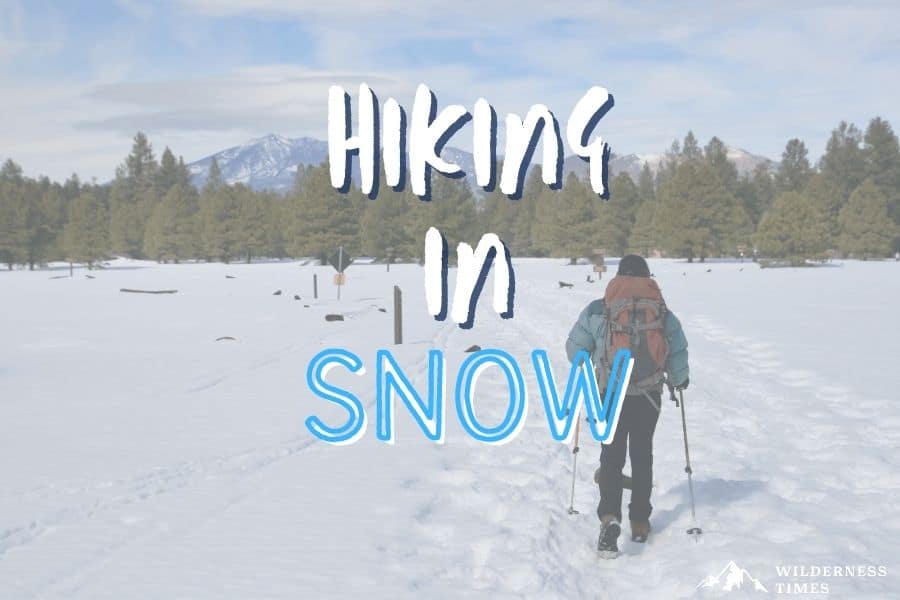The sight of the first snow doesn’t necessarily mean the end of the hiking season. Days may be shorter and cooler, but you can still spend them in the great outdoors.
However, to enjoy snow hiking to the fullest, you need to be well prepared. That’s why I’ll share with you everything you need to know before hitting the trail – from what to bring to how to act in certain situations.
Let’s dive in!
Snow & Winter Hiking Essential Tips
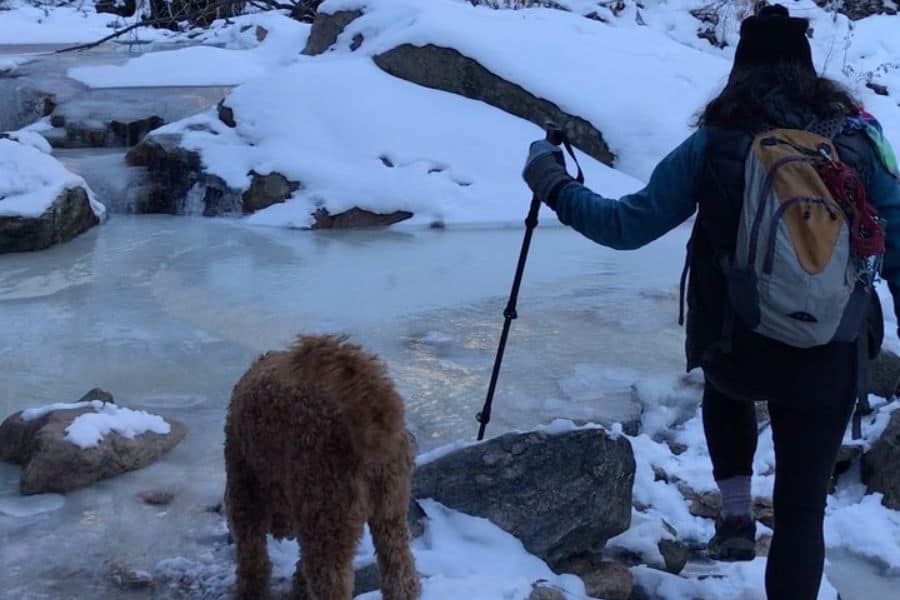
The first thing you should know is that winter hiking is way different from hiking in other seasons. Here are some essential things you should be aware of:
Staying Hydrated
In cold weather, we lose more water from our bodies through breathing. Wearing too many layers also causes fluid loss by sweating. But since the sweat evaporates so quickly in low temperatures, we might not realize it.
And while our bodies get dehydrated faster in cold weather, our thirst response is working in slow motion. So by the time you start feeling thirsty, you’re already dehydrated.
Instead of relying on body signals, you should drink water on a schedule to stay hydrated while hiking. Aim to drink about 33 ounces every two hours, but don’t chug it down. Instead, take regular sips every 20 minutes.
Hiking During Daylight Hours
Not only are daylights much shorter during winter, but temperatures drastically drop as the sun sets below the horizon. That’s why you should make the best use of sunlight hours and start your hike as early as possible.
Bring Snacks To Stay Nourished
Walking in snow requires more effort from your legs and heart than walking on packed terrain. You’ll get tired easily, so bring snacks to restore lost energy.
But since days are short and cold, you don’t want to waste time preparing or eating food. Instead, you should pack nutrient dense food that you can eat on the go, such as nuts, energy bars and fresh fruit.
Bring A Warm Drink In A Thermos
Since you’re trying to stay hydrated while hiking, you might as well make it enjoyable. And what’s better than a hot drink on a cold day to warm you up from the inside out? Just make sure to choose a vacuum-insulated thermos, as it can keep your drink hot for hours.
Warm Clothing/Layering
Layering clothes allows you to adapt to temperature changes throughout the day. During winter, you should wear as many as three layers.
The base layer goes right against your skin and wicks moisture away. The middle layer serves as insulation, while the outer layer shields you from weather conditions.
Footwear Options
Your choice of footwear for snow hiking needs to be waterproof, grippy and comfortable. But whether you go for shoes or boots – it’s up to you!
Shoes are lightweight, breathable and provide good ankle support. Boots are less supportive but more covering. And when it comes to warmth, they win by a large margin.
If you already own a decent pair of all-terrain hiking boots, you can wear them in snowy conditions too. But if you plan on hiking in freezing temperatures regularly, you should consider getting snow boots as well.
These boots are specially designed for walking on snow. Compared to classic hiking boots, snow boots come up high on the calf and prevent snow from getting in your boots. They also provide better traction on slippery surfaces.
Finally, we can’t forget about traction footwear accessories, with most common options being microspikes and crampons. Microspikes provide additional traction on trails covered with packed snow or ice. Crampons have larger teeth, and should be worn when walking on steep and ice-covered terrain.
Hiking In The Snow 101
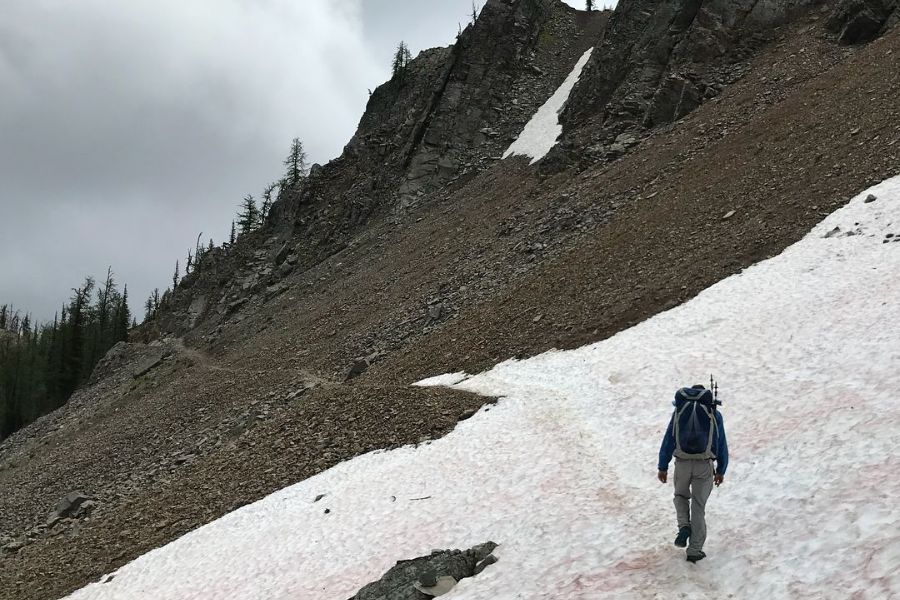
If it’s your first time hiking in the snow, you probably have tons of questions popping in your head.
Is It Safe To Hike In The Snow?
We can all agree that walking on snow can be challenging. But if you’re well prepared and educated, there’s no reason why you can’t hike safely in such conditions.
This means you need to plan ahead. In this section, I’ll cover the things you absolutely need to know before you hit the trail.
What Do You Need For Hiking In Snow?
Your list of hiking essentials applies here too. But, there are other things you need to add to the list for winter hiking.
First are trekking poles. They help you keep balance on slippery terrain and relieve pressure on your joints and knees when going downhill. But, you can also use them to check for holes underneath the snow and avoid potential injuries.
Crampons are another important addition to your packing list. They give you traction so that you can safely cross over slippery ice and hard-packed snow. You might not need them on the trail, but you should always have them packed, just in case.
The same goes for an ice axe. It’s an essential tool that helps you keep the balance or even self-arrest and prevent falling. You can also use it to climb steep slopes by using it as an anchor.
Can You Hike In Snow Without Snowshoes?
Theoretically, you can hike in the snow without snowshoes – but only if you’re walking over a trampled footpath. If you encounter deep snow, you’ll sink into it up to your waist.
What snowshoes do is increase the surface around your feet, which allows you to distribute the weight on the snow below. It’s basic physics. Snowshoes were invented over 4,000 years ago, and they haven’t changed much since.
Tips On Glacier Hiking
Glacier hiking can be extremely fun, but it’s just as dangerous. As you probably know, glaciers are a mass of accumulated snow that transformed into ice over the years.
But did you know that glaciers are constantly moving?
When pressured by its own weight and gravity, ice deforms and causes the glacier to slide around. That movement is what makes walking over it dangerous, as it can cause a block of ice to break off and fall.
If you intend to overtake glacier hiking, here are some tips on how to do it safely.
Travel in a team – Even with the proper gear, there’s a high risk of slipping and falling into a crevasse. Getting out is difficult, if not impossible without the help of others.
Rope team members together – In case someone does fall into the crevasse, other team members can easily arrest them using the rope.
Have an experienced glacier hiker in your team – You should never do this without someone that knows the area and has adequate training to solve unexpected situations that might happen.
Use proper equipment – Aside from the snow hiking essentials I’ve already mentioned above, you’ll need a glacier rope, as well as a harness with carabiners. As for rescue equipment, bring a snow picket, extra rope and a couple of pulleys.
Snow Hiking Safety
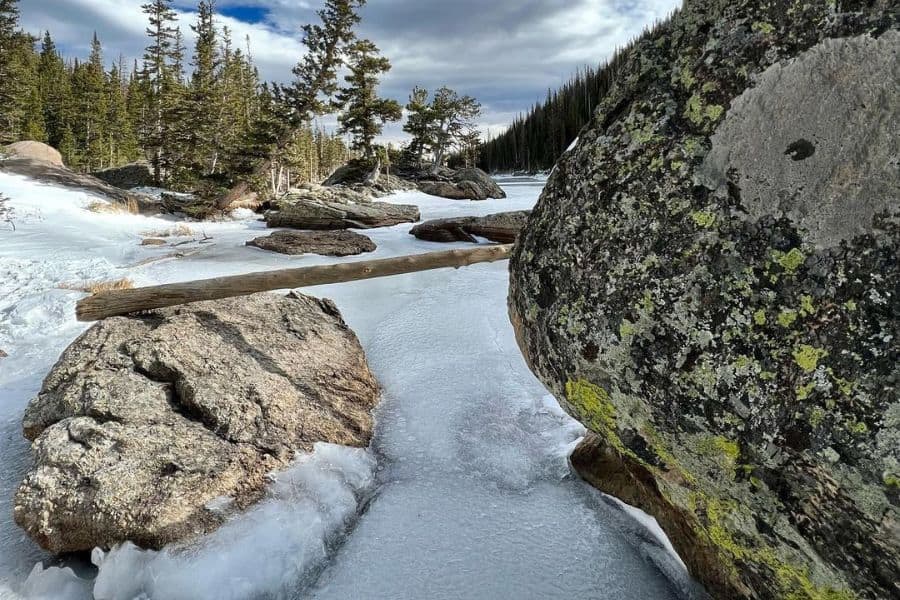
Safety comes first. While you don’t want to be weighed down by unnecessary gear, there are some things you should always have close at hand to ensure your safety on the trail.
First Aid
Accidents happen. No matter how careful you might be, sometimes you can’t avoid them. What you can do is prepare for them. This includes having a first aid kit.
There are tons of things you can include in your first aid kit, but some things are absolute essentials. Since most common hiking injuries are cuts and blisters, you should stack on band aids and bandages.
Another thing you should pack is medicine. Painkillers and antihistamines are necessary for obvious reasons. Topical antibiotics can’t hurt either, as they prevent cuts and bruises from getting infected.
Finally, every first aid kit needs to have an emergency blanket. In case of hypothermia, this thing can save your life.
Map, Compass & GPS Device
It’s easy to get lost when everything around you is covered in snow. If the weather’s nice, you can follow in your footsteps to get back on track. But if that’s not the case, you should have navigation tools available.
A GPS device allows you to navigate on the go. But freezing temperatures can slash battery life, and even cause the device to turn off, thus rendering it useless. That’s why you should always keep it in a pocket that’s close to your body to keep it warm, as well as pack extra batteries.
Still, you shouldn’t rely solely on electric devices to help you find your way around. That’s why every serious hiker should have a compass and a map with them.
Avalanche Risk
Avalanches are no joke. Anyone that’s going through the mountains during winter should know how and why they happen, as well as what to do in that case.
Types Of Avalanches
Avalanches are classified into four groups:
Loose snow avalanche – These are formed by the top layer of snow that’s either fresh or thawed, and thus loose. They start from a single point, but gather more snow and increase in size on their way down.
Slab avalanche – These occur when a large block of ice breaks off and slides down the mountain. They move at high speed, which makes them dangerous even when small in size.
Powder snow avalanche – As a dense avalanche occurs, it forms a cloud of powdered snow. It can move at speed up to 190 mph and cause immense damage.
Wet snow avalanche – Rain and higher temperatures can cause the snow to become damp, lose its density and slide. They move at a slow speed, but can accumulate and cause significant damage.
Checking Avalanche Conditions
Before you hit the trail, check avalanche forecasts. There’s a big network of avalanche centers across the country that share daily conditions and warn of potential avalanche dangers.
They use numbers (1-5) and colors (green, yellow, orange, red and black) to show the danger rating of a specific avalanche. Centers also issue travel advice and warnings, and you should take them seriously.
Beacons & Avalanche Safety
When hiking through avalanche-prone areas, you need to carry rescue gear and know how to use it. If you don’t, you can take an online course to learn everything you need to rescue either yourself or other people in case of emergency.
Finding people lost in avalanches is like searching for a needle in a haystack. Unless they’re wearing a beacon. This is a tiny device that transmits and receives radio signals, which helps rescuers find avalanche victims.
I’ll admit, beacons are quite expensive. But you can’t put a price on life, can you? If you’re hiking through avalanche-prone areas, this is an essential piece of equipment.
Hypothermia
As you probably know, hypothermia occurs when your body temperature drops below normal. It’s a medical emergency that should be taken seriously, as it can lead to heart and lung failure, and eventually death.
Conditions That Can Lead To Hypothermia
When your body is exposed to cold temperatures for a longer period of time, it might cause your body to lose heat faster than it’s able to produce it. Here are most common conditions that can lead to this happening:
- Being outdoors in cold temperatures for too long
- Not being dressed warm enough for current weather conditions
- Falling into the water and not being able to change into dry clothes
- Being exhausted and dehydrated
- Drinking alcohol, which is known to cause heat loss
Symptoms Of Hypothermia
Prevention is the best cure. But to be able to prevent hypothermia, you need to know the signs and symptoms. These can be grouped into three stages:
- Mild – Symptoms include intense shivering, increased breathing, numb hands and impaired judgement. It occurs when the body temperature drops to 90-95 degrees Fahrenheit.
- Moderate – As body temperature continues to drop, breathing and pulse become slower. A person can experience confusion, lack of coordination and sleepiness. At this point, there’s a high chance of arrhythmia.
- Severe – When body temperature drops below 89 degrees Fahrenheit, shivering stops. The cold is still here, but the body has lost the ability to respond, and the person loses consciousness. It’s only a matter of time before the heart stops.
What To Wear Hiking In The Snow
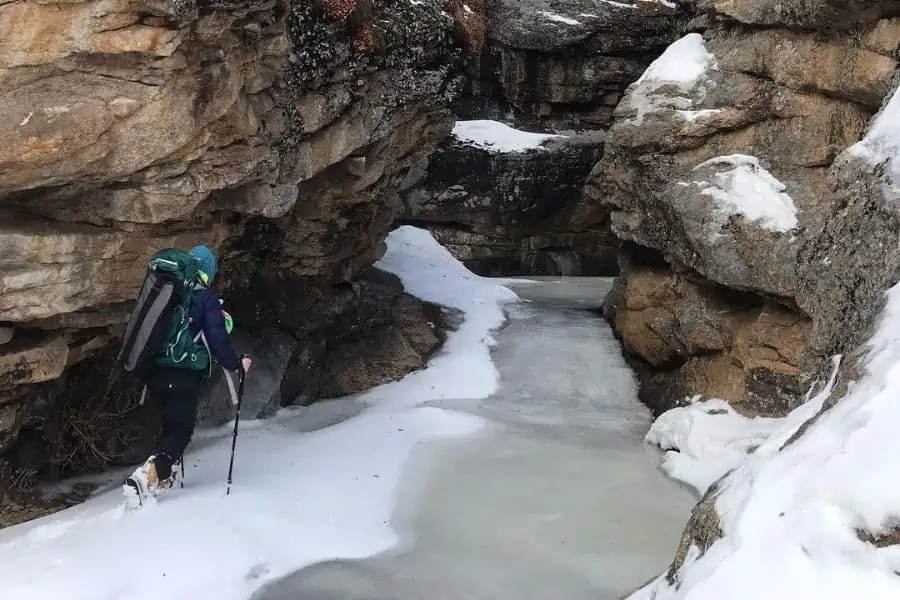
Finally, let’s talk about what you should wear to stay safe and warm when hiking in the snow.
Footwear
Your shoes need to be both waterproof and insulated – without exception. And since you’re walking on slippery surfaces, they should also give you ankle support to prevent injuries.
Walking in shoes that don’t fit your right is difficult enough without adding snow to the equation. When choosing the right footwear for snow hiking, you have to make sure it fits you like a glove. But don’t forget that you’ll be wearing warm socks, so this might mean going up a size.
If you’re walking through deep snow, you’ll need gaiters too. They prevent the snow from entering your boots and wetting your feet.
Pants
Depending on the temperature, you can layer pants too. The base layer should be warm, comfortable and moisture-wicking. You can’t go wrong with either synthetic or merino wool tights. But stay away from cotton, as it doesn’t insulate well and takes ages to dry.
As for the outer layer, it needs to be both waterproof and windproof. Rain pants are a great choice, since they’re lightweight and comfortable. Plus, you can wear them without inner layers during warmer months.
For additional warmth, you can choose insulated ski pants. These are designed to keep you warm in freezing temperatures. However, they might be too warm for intense hikes.
Jackets/Shells
Once again, layering is crucial. The outer layer needs to be waterproof but breathable. Ideally, it should also be lightweight and packable, so that you can store it away when you’re not wearing it.
While the outer layer protects you from weather elements, the inner layer is designated to keep you warm. Fleece jackets are a popular choice, and for good reasons. They’re soft, fast-drying and affordable.
In terms of warmth, nothing beats down. Still, it loses insulating properties when wet, so it might not be the best option. Sure, you’re wearing a waterproof shell over it, but if you start sweating, it will soak up the moisture, leaving you without an insulating layer.
Gloves
Last, but not least – a great pair of winter gloves is essential for hiking in snow. The last thing you want to be dealing with is cold or wet hands. A thick snow glove is going to be your best get, and ideally one that is extremely waterproof, yet breathable.
To Sum Things Up
There’s no reason to sit at home during winter and daydream about spring hikes.
Sure, hiking in snow can be challenging, but as long as you’re prepared with adequate knowledge and equipment, you can enjoy hiking all year round!

